The Intersection of Architecture and Ecology: A Biodiversity Perspective
Did you know the global construction industry creates almost 40% of the world’s carbon emissions? This fact shows we urgently need to rethink our construction methods. Architects through history have taken cues from nature in their designs. This approach, known as biophilic design, seeks to improve life by blending nature with our buildings.
Besides, sustainable architecture and biophilic design grow more popular. They focus on integrating nature into buildings. This trend not only makes spaces look appealing but also boosts our well-being. The aim is to explore how this design benefits us, connect us to nature, and fits into the idea of sustainable architecture. We’ll look at how famous buildings use these ideas. And we will discuss how biophilia, our natural love for nature, plays a role.
Key Takeaways
- The construction industry accounts for nearly 40% of global carbon emissions, highlighting the need for sustainable design.
- Biophilic design integrates nature into architectural concepts to enhance well-being and promote sustainability.
- This article will explore the benefits of biophilic design and its intersection with sustainable architecture.
- Biophilia refers to the innate human connection with the natural world, which biophilic design aims to foster.
- The integration of nature into the built environment can create a harmonious coexistence between architecture and ecology.
Embracing Nature in Built Spaces
At the heart of biophilic design is putting nature into our buildings. It recognises our strong tie to the natural world. This design style uses natural materials and living parts to mirror our love for nature in buildings.
The Essence of Biophilic Design
Biophilic design brings nature into building designs. This way, spaces are made that are good for our minds and bodies. By including nature, we feel better and more alive in these places.
Nature is not just seen; it’s felt and enjoyed in these designs. It’s about creating places that not only look beautiful but also work to make us feel happy and healthy. This is the power of biophilic design.
Environmental Architecture’s Sustainable Embrace
On the flip side, environmental architecture is all about being green. It uses methods that save energy, resources, and are kind to the earth. This way of building keeps in mind the whole life of a building, from the start to when it’s no longer used.
Both biophilic design and environmental architecture value nature and living gently on the planet. They work together to create buildings that are both good for us and for Earth. It’s a framework that supports green living and our need for nature.
This mix of biophilic design and environmental architecture is special. It unites caring for our environment with our deep connection to nature. By using this combination, designers and architects can make spaces that are kind to the earth and good for our well-being.
Biodiversity Through Ecological Architecture
Ecological architecture focuses on helping different plants and animals to thrive. For example, green walls are like gardens on vertical surfaces. They support many types of plants, insects, birds, and more. This makes them key spots for biodiversity.
Modern cities have a lot of concrete. This makes green walls very important. They help by cleaning the air, taking in harmful gases, and giving out fresh oxygen. These living walls boost air quality and help people live healthier. They are vital for the health of the whole ecological architecture around us.
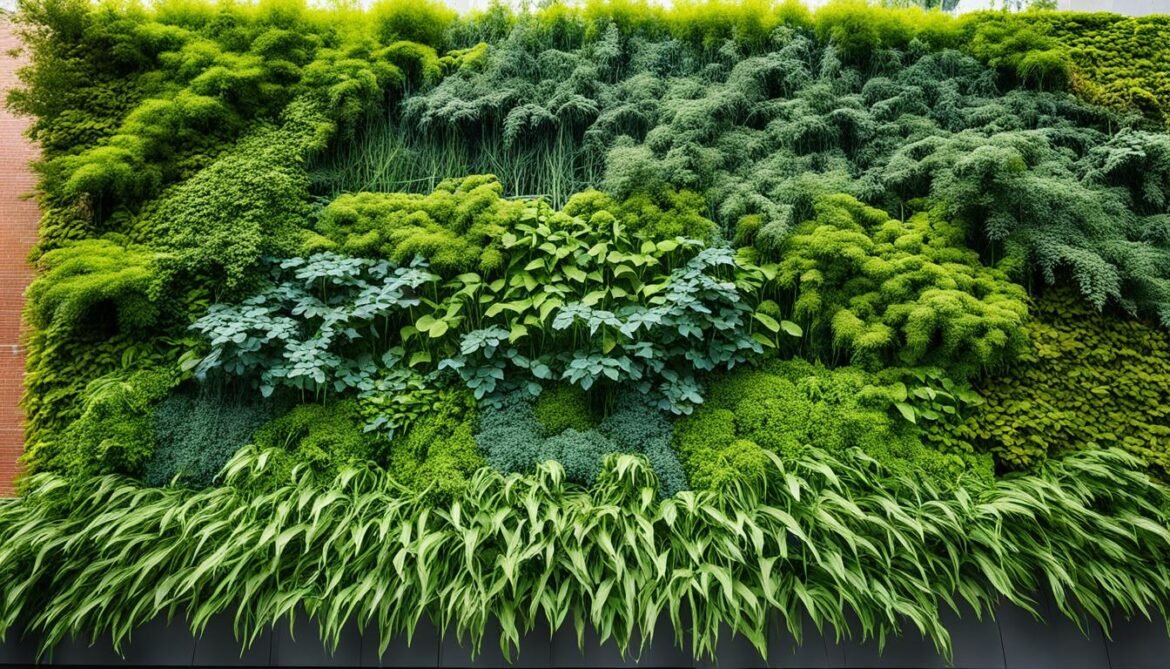
The Intersection of Architecture and Ecology: A Biodiversity Perspective
The mix of environmental architecture and biophilic design goes beyond looking good. It joins old ways with new ideas. This combination makes places that are not just beautiful but also do right by the environment. They are also meaningful to our culture. As experts keep exploring, we’re looking at a future full of sustainable homes. These will blend nature with architecture.
Imagine green skyscrapers with plants growing on them. Think of designs focused on making people happy. This new way of thinking has endless possibilities.

This coming together of environmental architecture and biophilic design is vital. It leads to green buildings. They fit in with city nature and help support our biodiversity dream.
How do we get there? By mixing green design and biophilic architecture. This helps us use less of the earth’s resources. We also feel more connected to the environment. Building this way is good for us and the planet.
Creating Synergy: Where Sustainability Meets Biophilia
The combination of biophilia and sustainability is clear in the use of living walls. These walls don’t just make a building look better. They also help save energy, improve air, and make people feel better. Seeing green against hard city fixtures gives a hint of nature to city life.
Natural Light and Ventilation
Natural light and ventilation are key in green architecture. It’s all about depending less on artificial systems. So, buildings with biophilic designs have big windows, sky roofs, and big, open areas. These not only light up the place but keep the outside close for those inside.
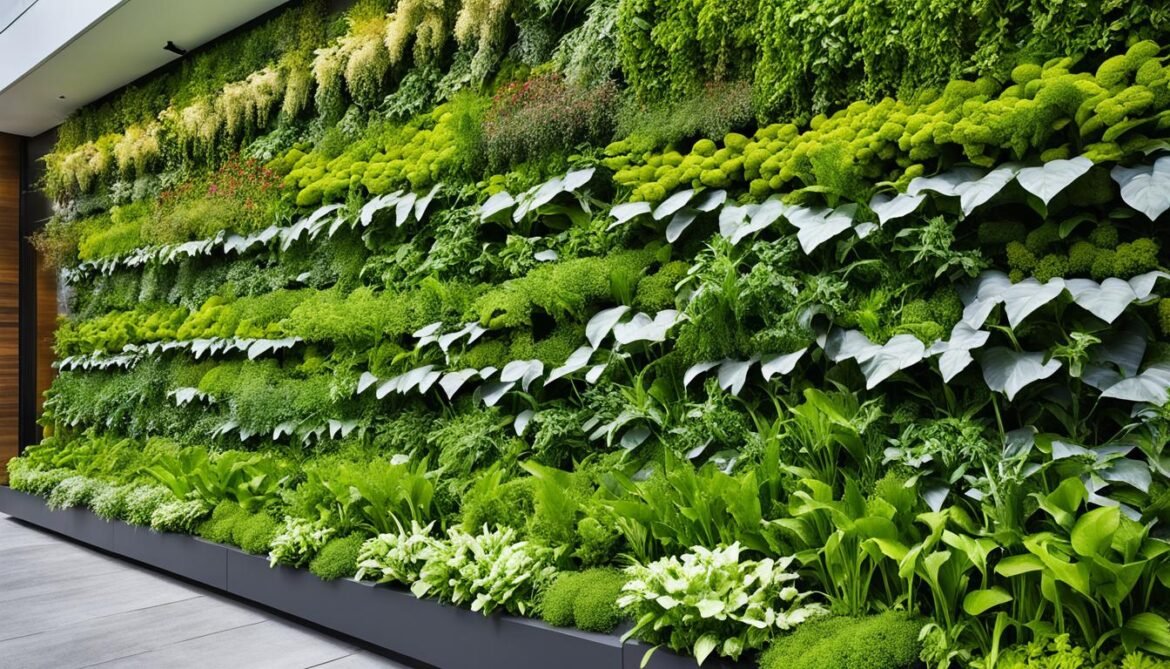
The Human Experience: Improved Well-being and Productivity
Many studies show nature helps us feel better. Things like indoor plants and water features can make us less stressed and feel happier. This is what environmental architecture is all about. It designs spaces to make us healthier and happy with nature.
Biophilic Design and Well-being
Architects use biophilic design to make buildings calm and to help people feel refreshed. These designs improve productivity and the overall human experience. They show how nature can be part of a building to make us feel better and work better.

Bringing nature into buildings is more than just looks. It’s about blending nature, good design, and eco-friendliness to make us feel great and work well. This approach combines the best of both eco-architecture and biophilic design to enhance every aspect of life in a space.
Sustainable Materials and Aesthetics in Ecological Architecture
In the world of ecological architecture, the choice of materials is key. Architects now prefer sustainably sourced wood, recycled items, and eco-friendly choices. These materials make structures more sustainable and give them a natural, inviting look.
Architects reduce environmental harm by picking materials that are renewable, recycled, and from nearby. This not only makes buildings look better but also shows a strong care for the planet.
Today, ecological architecture’s focus is on sustainable materials combining with aesthetics. This mix turns buildings into beautiful spaces that also speak of the designer’s love for the environment.
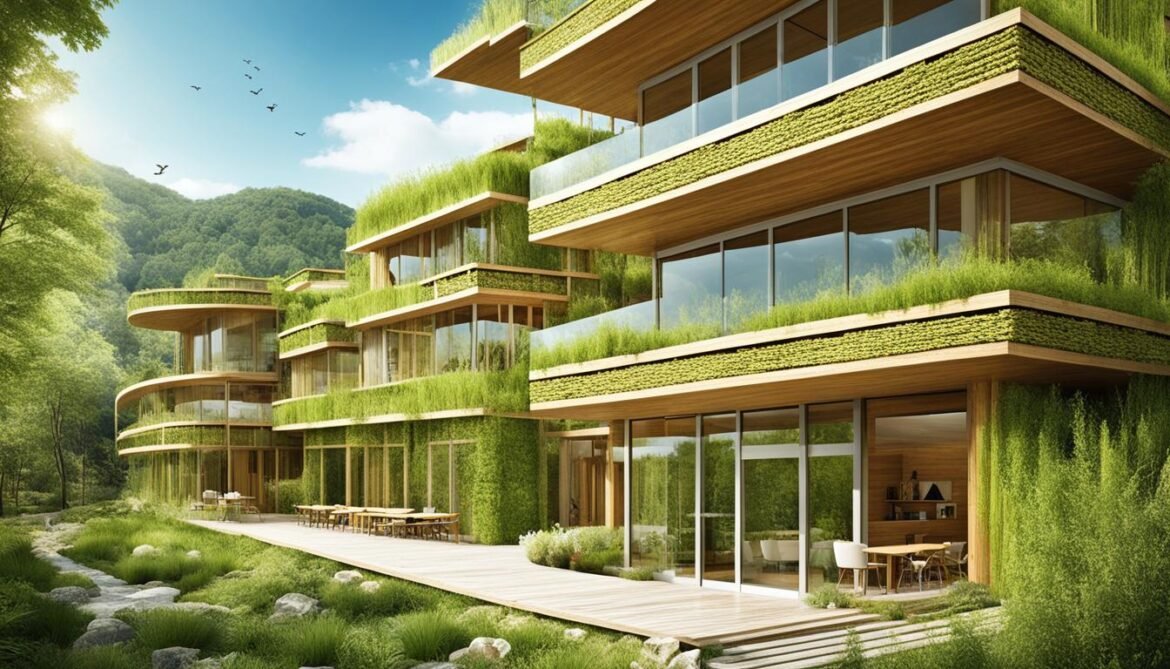
Beyond Aesthetics: A Harmonious Coexistence
Environmental architecture and biophilic design go beyond looks. They mix tradition and innovation. This brings together old architectural wisdom with new cutting-edge ideas. These spaces look gorgeous yet are friendly to the planet and steeped in culture. The future is bright, with sustainable living spaces becoming the norm. They blend the best of environmental architecture and biophilic ideas.
Bridging Tradition and Innovation
Imagine skyscrapers with lush green walls and designs that put people first. There’s endless room for creativity. This blend of tradition and innovation shows how the field is always changing for the better. It’s not just about what looks good but what makes us feel good too.
A Sustainable Tapestry of Living Spaces
Global issues like too many people in cities and protecting our planet are real. Yet, the mix of environmental architecture and biophilic design gives us hope. It’s through sustainable living spaces that we can build our future. These buildings will be gentle on the earth and bring us closer to nature.
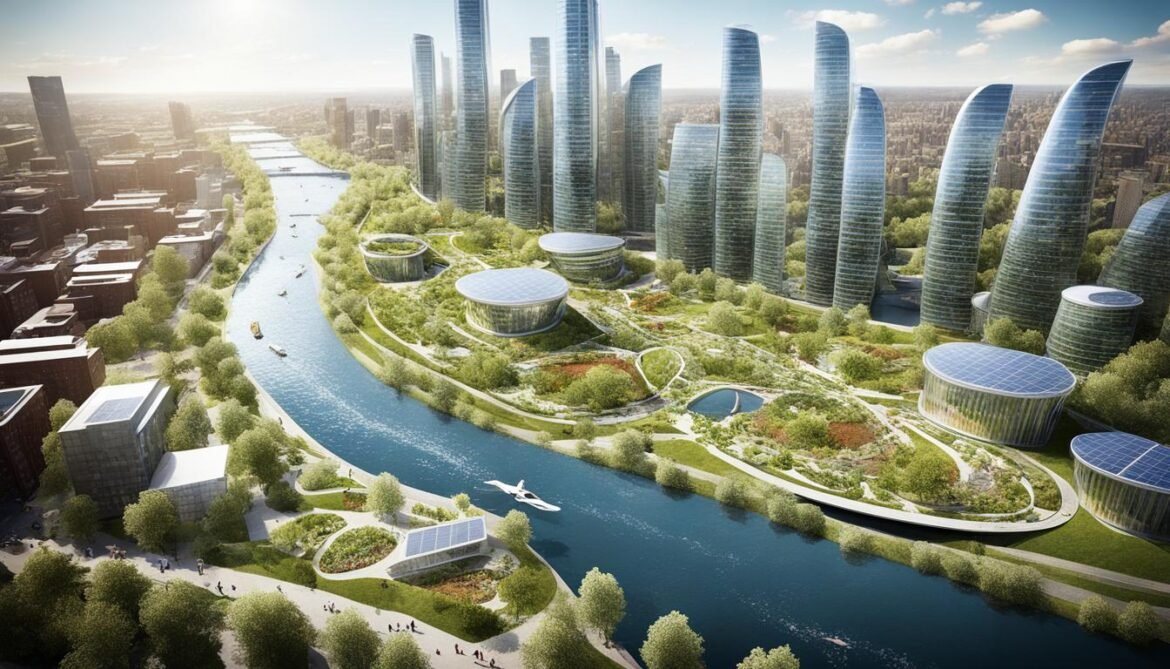
Understanding Biophilic Design’s Contribution to Sustainability
Biophilic design is about blending nature into our buildings. It makes the places we live and work in more than just structures. Using biophilic design, we can make spaces better for people and the environment. This approach also helps with issues like biodiversity and tackling climate change.
The beauty of biophilic design is how it supports nature. It gives homes to many creatures and improves our world in ways like helping plants grow or taking care of excess water from rain. This approach leads to using materials that are better for the planet. It does this by cutting down waste and making it easy to change a space later on.
This way of building makes our homes and workplaces tougher against bad weather, too. Think of the cool breezes you get or the way the sun naturally warms a room. This all happens without using tons of energy.
| Principle | Contribution to Sustainability |
|---|---|
| Biodiversity | Supports conservation and provides habitats for various species |
| Circularity | Encourages sustainable materials and enables future adaptation |
| Resilience | Helps create structures that can adapt to changing climate conditions |
Adding these ideas to how we design buildings means our spaces are good for us and kind to the planet. It’s not just about the look but also the impact on our lives and the future we’re building.

Improve Well-being and Connection to Nature
Biophilic design makes spaces better by adding nature indoors. This includes plants, natural views, light, and green areas. It makes people feel more at ease and closer to the natural world. Thus, it boosts the quality of life for those in the building.
It links us with nature, giving us healthier work and living areas. This connection is vital for biophilic design and sustainable architecture. Such designs not only help us feel better but also improve our bond with the environment.
| Benefits of Biophilic Design | Sustainable Architecture Outcomes |
|---|---|
| Improved well-being and comfort | Enhanced quality of life for occupants |
| Deeper connection to nature | Harmonious human-nature relationship |
| Increased productivity and focus | Contribution to a sustainable future |
Contributing to Biodiversity and Ecosystem Services
Adding nature to our buildings helps protect biodiversity. Things like green roofs, living walls, and special paths let us make urban ecosystems. These places offer homes for many animals, helping to keep them and the plants alive. This means more bees and better ways to manage when it rains. Bringing nature into our cities through ecological architecture is important. It makes our cities greener and helps plant and animal life to thrive.
| Benefits of Integrating Nature into Buildings | Ecosystem Services Provided |
|---|---|
| Biodiversity conservation | Pollination |
| Creation of urban ecosystems | Stormwater management |
| Habitat provision for various species | Air purification |
| Sustainable urban development | Climate regulation |
Choosing green infrastructure and urban ecology helps our future be richer and healthier. We work with nature to build spaces that add, rather than take away from, the planet.
Circularity and Sustainable Material Choices
Biophilic design urges architects to pick materials and methods that are kind to the planet. They should choose things like renewable, recycled, and local materials. This choice helps shrink a building’s ecological footprint.
Designing buildings that can change or last a long time also matters. This promotes circularity. It means less waste and the chance to use spaces for different things over time.
| Material | Sustainability Factors | Ecological Impact |
|---|---|---|
| Sustainably Sourced Wood | Renewable, Recyclable, Biodegradable | Reduced ecological footprint, Supports Forestry Management |
| Recycled Plastics | Circular, Reduced Virgin Material Use | Diverts Waste from Landfills, Conserves Natural Resources |
| Locally Sourced Stone | Reduced Transportation Emissions, Supports Local Economy | Minimises carbon footprint, Encourages adaptability and longevity |
This way of choosing materials and designing fits the green goals of architecture. It makes buildings not just look good but also be good for the Earth. This happens during their whole life.
By going circular and focusing on sustainable materials, architects can make buildings that do less harm. They can help create a built world that’s more adaptable and long-lasting.
Building Resilience in the Face of Climate Change
Biophilic design is key in making buildings strong against climate change. It uses natural ways to keep indoor spaces comfortable. This lowers carbon footprints and helps in warmer weather.
Natural ventilation is at the heart of biophilic design. It manages indoor temperatures without energy-heavy systems. This is vital as heat waves become more common. Using the sun for light and warmth is another smart design. It decreases power use and makes buildings tougher.
Adding green features, like living walls, brings many pluses. They soak up rainwater, reducing flood risks. They also cool cities, fighting the urban heat effect. These help in keeping buildings safe from climate change.
| Biophilic Design Strategies | Contribution to Resilience |
|---|---|
| Natural Ventilation | Regulates indoor temperatures, reduces energy needs, and prepares for extreme heat |
| Passive Solar Design | Harnesses the sun’s energy to warm and light the interior, reducing fossil fuel dependence |
| Green Infrastructure | Absorbs stormwater, mitigates urban heat island effect, and improves air quality |
Using biophilic design in architecture offers a complete way to build resilience. It ensures our buildings can face climate change. Nature-friendly designs not only look good but are also efficient and ready for the future’s challenges.
Conclusion
Adding biophilic design to sustainable architecture is a game-changer in solving sustainability issues. It makes the link between people and nature stronger. This boosts well-being, supports biodiversity, follows the idea of circularity, and strengthens resilience. These concepts help architects and designers make eco-friendly buildings. These buildings make our future better and offer healthier and uplifting spaces for us.
The merging of environmental architecture and biophilic design is more than just looks. It combines old and new to form a green living art. This art is rich in sustainability and bonds with nature. We face many challenges in construction. To solve them, we should focus on the link between architecture and ecology. Doing so is key to a greener and more varied world.
The link between architecture and ecology is vital. It lets us make the most of biophilic design and sustainable architecture. This approach doesn’t just look good. It also feeds our sense of wonder, health, and nature. In the end, it promises us a world where our buildings and nature live in perfect balance.
FAQ
What is the essence of biophilic design?
The core of biophilic design is merging nature with man-made structures. It recognises our deep ties with the natural world. This method aims to design places that reflect our love for nature. It achieves this through natural materials, patterns, and plant life.
How does environmental architecture focus on sustainability?
Environmental architecture aims for structures that use energy wisely and conserve resources. It tries to lessen harm on the environment. It’s about the green impact from the start to the end of a building’s life.
How do green walls contribute to urban biodiversity and air quality?
Green walls are like small natural habitats. They support many plant species and draw in insects and birds. These walls clean the air by filtering out harmful substances. They also help produce oxygen, making cities greener.
What are the key aspects of the intersection between environmental architecture and biophilic design?
Environmental architecture and biophilic design mix old and new ideas. They create spaces that are both beautiful and good for the planet. This approach links design with nature. It aims for harmony between human creations and the environment.
How do living walls contribute to the synergy between sustainability and biophilia?
Living walls are more than just pretty; they help save energy, clean the air, and make people feel better. They introduce a natural look to city areas. This fits with the goals of both sustainable and nature-friendly design.
What are the benefits of biophilic design elements for human well-being and productivity?
Research shows that being around nature makes us feel better. It lowers stress, boosts brain power, and cheers us up. Features like plants and water in design create peaceful and inspiring areas. They help everyone do better and feel good.
How do sustainable materials used in ecological architecture align with biophilic principles?
Eco-friendly buildings often use materials that connect with the natural world. They choose wood from sustainable sources, recycled items, and other green choices. This makes structures good for the earth and look inviting. It combines a lovely look with care for the planet.
How does the intersection of environmental architecture and biophilic design contribute to a sustainable future?
This mix is not just about look and innovation. It works on a deeper level to create living places that blend with the earth. It unites nature and design to meet sustainability goals. This means healthier, more biodiverse, circular, climate-resilient spaces.
How does biophilic design contribute to biodiversity, circularity, and resilience in sustainable architecture?
Biophilic design brings nature into buildings. This not only feels good for us but also helps plants and animals. It uses green methods, materials, and designs to cope with climate changes. It supports city wildlife and lessens our environmental impact.
Source Links
- https://www.viritopia.com/blog/the-intersection-of-environmental-architecture-and-biophilic-design
- https://greenplantsforgreenbuildings.org/theintersecetionofbiophilicdesignandsustainablearchitecture/
- https://learn.constructive-voices.com/biodiversity-by-design-integrating-nature-into-architectural-concepts/



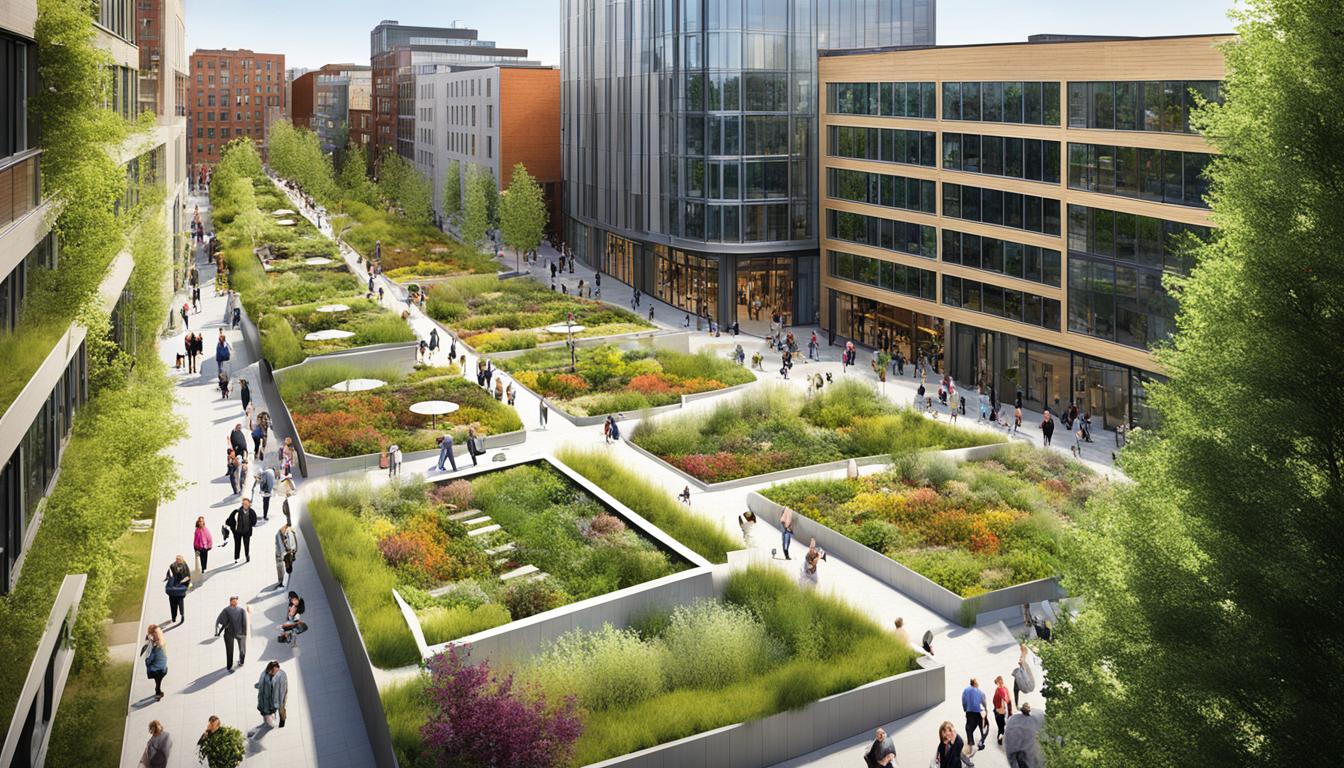




The Intersection of Architecture and Ecology: Nature-Positive Solutions - Learn at Constructive Voices
5 months ago[…] https://constructive-voices.com/the-intersection-of-architecture-and-ecology-a-biodiversity-perspect… […]